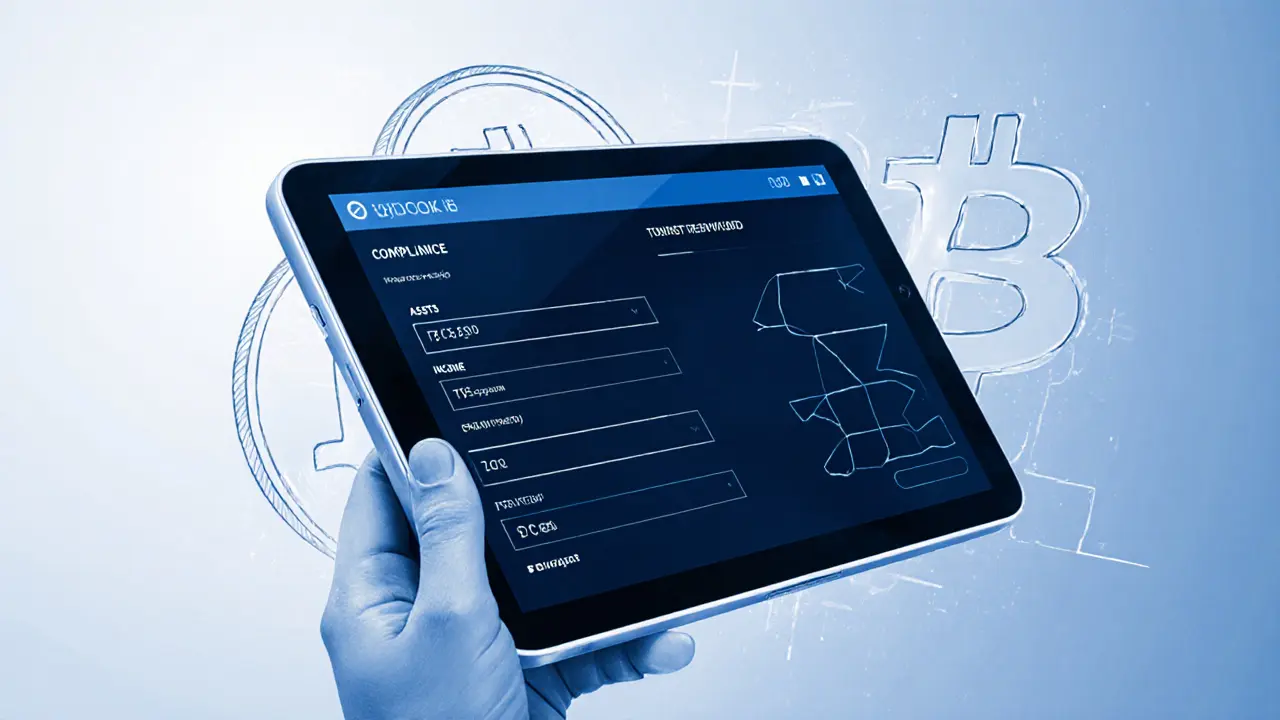Russia's Ruble Crypto Trading Restrictions 2025: Essential Guide for Investors

Russia's Ruble Crypto Trading Compliance Checker
Check Your Eligibility for ELR Crypto Trading
Enter your financial details below to determine if you qualify as a "qualified investor" under Russia's Experimental Legal Regime (ELR).
Your Compliance Status
- Assets Threshold: Hold more than 100 million RUB in assets
- Income Threshold: Earn more than 50 million RUB annually
- Transaction Reporting: All trades over 600,000 RUB must be reported to tax authorities
- Permitted Assets: Bitcoin, Ethereum, crypto-linked futures, tokenized invoices
- Regime Duration: Valid until end of 2027
When Russia rolled out its latest crypto framework, it created a split system that lets the ruble stay king at home while allowing Bitcoin and other tokens to power cross‑border deals. If you’re a trader, an exporter, or just curious about how the Russian government is juggling digital assets and sanctions, this guide cuts through the jargon and shows you exactly what’s allowed, what’s banned, and where the biggest risks lie.
Key Takeaways
- Domestic payments in any cryptocurrency remain illegal; only the ruble (including the forthcoming digital ruble) is legal tender.
- The 2024 Experimental Legal Regime (ELR) lets qualified exporters, importers, and high‑net‑worth investors use crypto for international settlements.
- Qualified investors must hold >100millionRUB in assets or >50millionRUB in annual income to trade crypto derivatives.
- All crypto‑related transactions above 600000RUB must be reported to tax authorities.
- By March2025, crypto‑facilitated trade hit 1trillionRUB, while private Russian wallets still hold about $25billion worth of digital assets.
Regulatory Timeline at a Glance
Russian Ruble Crypto Trading Restrictions are a set of laws and experimental rules that govern how digital assets can be used in Russia, especially in relation to the national currency, the ruble. emerged from a series of moves that began in 2020. The July2020 law legalized crypto transactions but barred them from being used for domestic payments, a rule that took effect on 1January2021. Fast‑forward to summer2024, and the Finance Ministry introduced the ELR, a three‑year pilot that opened a narrow doorway for crypto in international trade while keeping the domestic ban intact.
In March2025 the Central Bank of Russia (CBR) doubled down, urging lawmakers to keep all non‑ELR crypto activity criminalized. By October2025 the CBR even started studying Bitcoin as a hedge against ruble devaluation-signaling a possible future shift, but for now the dual‑track regime stays firm.
Domestic Prohibition vs. International Permission
Think of the regime as a two‑lane highway. One lane (the domestic lane) is closed to any crypto vehicle; only the ruble and its digital counterpart can travel there. The other lane (the international lane) runs through the ELR, letting a limited set of qualified players use crypto to bypass sanctions and settle foreign trade.
| Aspect | Domestic Use | International Use (ELR) |
|---|---|---|
| Legal Tender | Only RUB (and Digital RUB) | Cryptocurrencies allowed for settlement |
| Who Can Trade? | None (crypto payments banned) | Qualified exporters/importers and investors meeting high‑net‑worth thresholds |
| Reporting Threshold | 600000RUB | Same threshold, but reports go through ELR channels |
| AML/KYC Requirements | Standard banking AML | Enhanced AML, strict KYC, and real‑time monitoring mandated by CBR |
| Permitted Instruments | None | Bitcoin, Ethereum, crypto‑linked futures, and tokenized trade invoices |
These rules keep the ruble’s dominance at home while giving companies a crypto shortcut to settle with overseas partners, especially where Western banks have shut doors because of sanctions.
What the Experimental Legal Regime Actually Allows
Experimental Legal Regime is a three‑year pilot launched in 2024 that permits a limited set of Russian entities to use cryptocurrencies for cross‑border trade while maintaining a strict ban on domestic crypto payments. The ELR is not a free‑for‑all sandbox; it’s a tightly controlled corridor:
- Eligible participants: Russian exporters, importers, and “especially qualified” investors who meet the asset or income thresholds.
- Allowed crypto: Primarily Bitcoin and Ethereum, plus tokenized invoices that reference those coins.
- Transaction limits: No hard caps per transaction, but every trade over 600000RUB must be logged and reported to the Federal Tax Service.
- Duration: The regime runs until the end of 2027, after which a permanent framework will be drafted based on performance metrics.
In practice, the ELR has become a lifeline for firms looking to avoid SWIFT restrictions. By early 2025, the volume of crypto‑backed international settlements topped 1trillionRUB, showing that the limited gateway is being used intensively.

Who Qualifies as a “Qualified Investor”?
Qualified Investor in Russia is an individual who holds at least 100millionRUB in assets or earns more than 50millionRUB annually, granting them access to crypto derivatives under the ELR. The CBR set these thresholds to keep high‑risk retail exposure low and to ensure that only financially sophisticated participants can handle the volatility of digital assets.
Since the May2025 rollout, qualified investors have snapped up $16million worth of Bitcoin futures in the first month alone. The Finance Ministry has pushed for lower thresholds, arguing that broader access could boost capital market depth, but the Central Bank remains cautious, citing money‑laundering concerns.
Compliance Obligations: AML, KYC, and Reporting
Whether you’re a bank, a fintech, or an individual trader, the compliance checklist is long and unforgiving:
- Anti‑Money Laundering (AML): The CBR released detailed methodological recommendations in early 2025, demanding real‑time transaction monitoring, automated suspicious‑activity reporting, and cross‑institution data sharing.
- Know Your Customer (KYC): All participants in the ELR must undergo multilayer verification, including source‑of‑funds checks, passport scans, and proof of net‑worth for qualified investors.
- Reporting: Any crypto transaction exceeding 600000RUB triggers a mandatory declaration to the tax authority within 30 days. Failure to report can lead to criminal liability under the 2025 amendments.
- Bank Restrictions: Traditional banks cannot hold cryptocurrencies on their balance sheets, nor can they use the Russian financial infrastructure for non‑ELR crypto trades.
The heavy compliance load has spurred a wave of niche service providers that specialize in AML‑ready crypto wallets and reporting tools, but they still need to integrate with the central registry managed by the tax ministry.
Market Impact: Trade Volumes, Private Holdings, and Shadow Markets
Despite the strict domestic ban, Russian citizens collectively own an estimated $25billion in digital assets. Most of this sits on foreign exchanges, creating a gray market that operates outside official oversight. The shadow market thrives because the ELR does not provide a domestic exchange for ruble‑denominated crypto trades.
On the institutional side, the ELR has unlocked a $1trillionRUB flow for exporters who settle invoices with Bitcoin, effectively sidestepping sanctions‑related payment freezes. This volume has attracted the interest of major banks like Sberbank Russia's largest commercial bank, which now offers crypto‑linked financial products within the ELR framework. and the Moscow Exchange, which has launched futures contracts that track crypto prices.
The dual system also means the domestic economy remains insulated from crypto volatility-prices swing wildly on foreign platforms, but those swings don’t directly affect ruble‑based pricing in everyday transactions.
Institutional Participation and Infrastructure Development
Beyond Sberbank, the Moscow Exchange is issuing crypto‑linked derivatives, and several state‑backed mining projects are emerging in regions with surplus energy. Deputy Finance Minister Ivan Chebeskov Deputy Minister of Finance who champions building a national crypto infrastructure, including mining facilities. has repeatedly emphasized the need for homegrown infrastructure to reduce reliance on foreign platforms.
These moves hint at a longer‑term strategy: while the ELR is experimental, the state is laying the groundwork for a future where regulated mining, custodial services, and possibly a state‑issued digital ruble could coexist with controlled crypto trade.
Future Outlook: What to Watch in 2026‑2027
Several signals point to where the regime might head:
- Fund Access: The CBR hinted at allowing investment funds to hold crypto assets by 2026, which could dramatically widen institutional exposure.
- Digital Ruble Integration: As the digital version of the ruble rolls out, regulators may tie it to the ELR, creating hybrid settlement mechanisms.
- Policy Review: The three‑year ELR trial ends in 2027; lawmakers will decide whether to cement the current rules, tighten them, or expand crypto freedoms based on performance data and geopolitical pressure.
- Sanctions Landscape: Ongoing Western sanctions will keep the incentive high for using crypto in cross‑border trade, reinforcing the ELR’s relevance.
For now, the safe bet is to treat the ELR as a limited, high‑risk but high‑reward channel. If you qualify as a qualified investor or represent a company engaged in import/export, setting up compliant ELR processes now can give you a competitive edge when the permanent rules finally lock in.

Frequently Asked Questions
Can Russian individuals use Bitcoin for everyday purchases?
No. Domestic payments in any cryptocurrency are explicitly prohibited by law. Only the ruble, including its upcoming digital form, can be used for everyday transactions.
What qualifies a trader as a “qualified investor” under the ELR?
An individual must hold assets worth more than 100millionRUB or earn an annual income exceeding 50millionRUB. Meeting either threshold grants access to crypto derivatives and ELR‑approved trading platforms.
Do Russian banks like Sberbank offer crypto services?
Yes, but only within the ELR limits. Sberbank provides crypto‑linked financial products, such as futures contracts, for qualified investors and companies that need to settle international trade.
How are crypto transactions reported to Russian tax authorities?
Any transaction exceeding 600000RUB must be declared within 30 days using the standard tax‑reporting forms. Failure to report can lead to criminal charges under the 2025 amendments.
Will the Experimental Legal Regime become permanent?
The ELR is slated for review at the end of 2027. Legislators will decide whether to adopt a permanent version, tighten restrictions, or expand crypto usage based on the pilot’s outcomes and geopolitical shifts.

Manish Gupta
October 4, 2025 AT 02:26Gabrielle Loeser
October 4, 2025 AT 20:07Cyndy Mcquiston
October 5, 2025 AT 16:40Abby Gonzales Hoffman
October 6, 2025 AT 02:55Rampraveen Rani
October 6, 2025 AT 20:36ashish ramani
October 7, 2025 AT 12:44Natasha Nelson
October 8, 2025 AT 09:44Sarah Hannay
October 9, 2025 AT 07:44Richard Williams
October 9, 2025 AT 12:41Prabhleen Bhatti
October 10, 2025 AT 02:04Elizabeth Mitchell
October 10, 2025 AT 20:35Chris Houser
October 11, 2025 AT 17:24William Burns
October 11, 2025 AT 22:32Ashley Cecil
October 12, 2025 AT 22:31